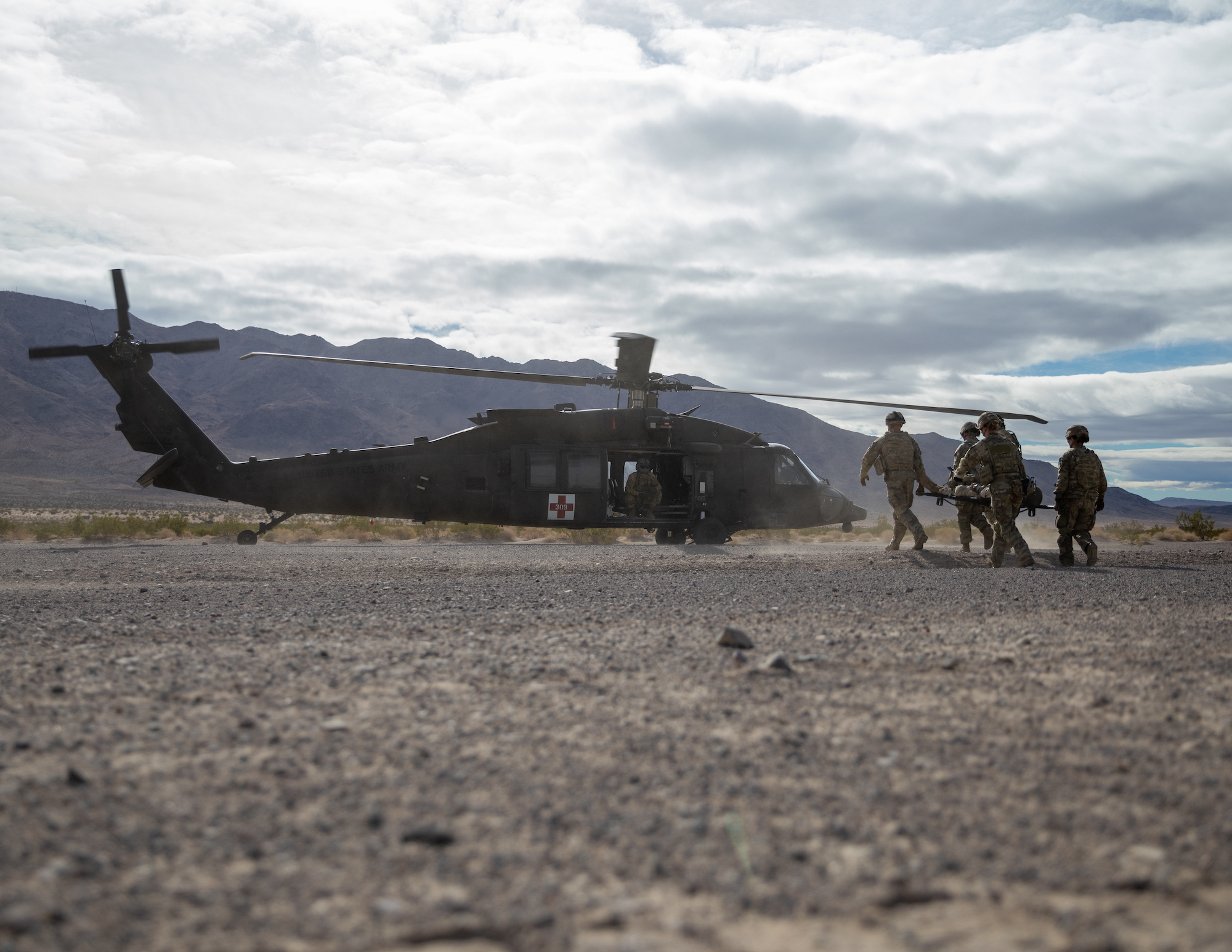

In the desert south of Death Valley, mock patients waited for drones to deliver simulated blood. California’s Fort Irwin is an Army base that hosted an event called Project Convergence 2022 from late September into November, an annual exercise led by the United States where militaries of multiple nations work together to explore new technologies in service of war. By testing drone delivery of medical supplies, in conjunction with other tech, the military is looking at ways to ensure the survival of soldiers after battle injuries, even in circumstances where it’s unsafe to send people on foot for help.
Part of Project Convergence was Project Crimson, which involved drones dropping medical relief to field medics in a simulated mass casualty scenario.
“Project Crimson is a project to take a common unmanned air system and adapt it to support a medical mission,” said Nathan Fisher, medical robotics and autonomous systems division chief at the US Army’s Telemedicine & Advanced Technology Research Center, in a release. “This drone supports medical field care when casualty evacuation isn’t an option. It can keep whole blood and other crucial items refrigerated in the autonomous portable refrigeration unit and take it to medics in the field with wounded warriors.”
Researchers first proved that drones could successfully deliver blood in 2015. As cargo, blood makes a lot of sense, since a small amount can be life saving, and drones can rapidly transport small cargoes as needed. In the summer of 2021, British marines tested blood delivery by drone swarm, with the dedicated resupply drones carrying everything from ammunition to blood to troops in the field.
For Project Crimson, the army used a FVR-90 drone, a vertical takeoff and landing UAV. Two outriggers attached to the drone’s wings each feature two rotors, allowing the FVR-90 to launch and land like a quadcopter. In flight, the FVR-90 flies like a fixed-wing plane, with a front-facing propeller and its over 15-feet wide wingspan allowing for long-lasting efficient flight of up to 16 hours. The FVR-90 tops out at 74 mph, but it can carry up to 10 pounds of payload under its wings, ready to drop and deliver.
The drone “doesn’t need a catapult launch or runway to perform a lifesaving mission. This allows military personnel to preserve life in the critical phase of injury and facilitate rapid transport to an Army hospital for further treatment,” said the release.

Beyond medical delivery drones, the army tested distant communication and diagnostic tools, designed to improve the ability of field medics to observe and manage the health of injuries in the field.
One of these is the Battlefield Assisted Trauma Distributed Observation Kit, or BATDOK. It’s a smartphone app that can work with sensors placed on the patients, scanning information and then storing it for up to 25 patients per device. This information can be shared over a mesh network with other devices, or transferred via protocols like Bluetooth and WiFi, letting a field medic pass along records seamlessly for a patient at the point of transfer to better care.
“The facility can see the patient’s status real-time using BATDOK, while the medics on ground can update treatments and medications for the patients as well. This allows the facility to be alerted, rally and prepare to treat the patient once they are transported,” explained Michael Sedillo, an integrated cockpit sensing program airman systems director with the Air Force Research Laboratory, in a press release.
As part of Project Convergence, troops carried litters of mock casualties to medical transports, with medics applying care in transit. At the field hospital, field medics and hospital staff traded records using local communications infrastructure, ensuring smooth flow of care.
Project Convergence included participants from the British and Australian Armies, with allied nations like Canada and New Zealand observing.
Ultimately, exercises like this will improve the ability of the military to not just fight wars, but to ensure that injury on the battlefield is dealt with as best as possible. Drone resupply of medical necessities like blood can keep people in the field alive longer until reinforcements or evacuation arrives. Better data management can make sure that as little information as possible is lost when transferring care, letting medical teams move forward in treatment as conditions allow.
As robots and new data tools move into greater use on the battlefield, training on these labor-saving devices should open up the possibility for human soldiers to focus directly on the tasks of saving lives, while machines provide the tools needed to do that.
Watch a video about Project Convergence below:

